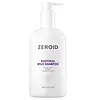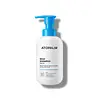What's inside
What's inside
 Key Ingredients
Key Ingredients

No key ingredients
 Benefits
Benefits

 Concerns
Concerns

 Ingredients Side-by-side
Ingredients Side-by-side

Water
Skin ConditioningLauryl Hydroxysultaine
CleansingDisodium Lauryl Sulfosuccinate
CleansingSodium Chloride
MaskingSodium Lauryl Glucose Carboxylate
CleansingLauryl Glucoside
CleansingPotassium Cocoyl Glutamate
Glycerin
HumectantPanthenol
Skin ConditioningBiotin
AntiseborrhoeicBis-Oleamido Isopropyl Alcohol
Emulsion StabilisingTrihydroxystearin
Skin ConditioningGuar Hydroxypropyltrimonium Chloride
Skin ConditioningPolyquaternium-22
Acrylamidopropyltrimonium Chloride/Acrylamide Copolymer
Sodium Phytate
Citric Acid
BufferingSodium Citrate
BufferingHexylene Glycol
EmulsifyingSodium Anisate
Antimicrobial1,2-Hexanediol
Skin ConditioningWater, Lauryl Hydroxysultaine, Disodium Lauryl Sulfosuccinate, Sodium Chloride, Sodium Lauryl Glucose Carboxylate, Lauryl Glucoside, Potassium Cocoyl Glutamate, Glycerin, Panthenol, Biotin, Bis-Oleamido Isopropyl Alcohol, Trihydroxystearin, Guar Hydroxypropyltrimonium Chloride, Polyquaternium-22, Acrylamidopropyltrimonium Chloride/Acrylamide Copolymer, Sodium Phytate, Citric Acid, Sodium Citrate, Hexylene Glycol, Sodium Anisate, 1,2-Hexanediol
Water
Skin ConditioningDisodium Lauryl Sulfosuccinate
CleansingLauryl Hydroxysultaine
CleansingSodium Chloride
MaskingLauryl Glucoside
CleansingSodium Lauryl Glucose Carboxylate
CleansingSodium Methyl Oleoyl Taurate
Cleansing1,2-Hexanediol
Skin ConditioningGlycerin
HumectantCitric Acid
BufferingSodium Anisate
AntimicrobialPolyquaternium-10
Panthenol
Skin ConditioningPyrus Communis Fruit Extract
Skin ConditioningPyrus Malus Leaf Extract
Skin ConditioningCrataegus Monogyna Fruit Extract
Skin ConditioningVanilla Planifolia Fruit Extract
Skin ConditioningSodium Phytate
Hedera Helix Leaf/Stem Extract
AntimicrobialPrunus Amygdalus Amara Seed Extract
Skin ConditioningBiotin
AntiseborrhoeicTocopherol
AntioxidantPalmitoyl Palmitamide Mea
HumectantBis-Capryloyloxypalmitamido Isopropanol
EmollientN-Linolenoyl Serinol
Skin ConditioningLeucine
Skin ConditioningLysine
Skin ConditioningPhenylalanine
MaskingThreonine
Valine
MaskingWater, Disodium Lauryl Sulfosuccinate, Lauryl Hydroxysultaine, Sodium Chloride, Lauryl Glucoside, Sodium Lauryl Glucose Carboxylate, Sodium Methyl Oleoyl Taurate, 1,2-Hexanediol, Glycerin, Citric Acid, Sodium Anisate, Polyquaternium-10, Panthenol, Pyrus Communis Fruit Extract, Pyrus Malus Leaf Extract, Crataegus Monogyna Fruit Extract, Vanilla Planifolia Fruit Extract, Sodium Phytate, Hedera Helix Leaf/Stem Extract, Prunus Amygdalus Amara Seed Extract, Biotin, Tocopherol, Palmitoyl Palmitamide Mea, Bis-Capryloyloxypalmitamido Isopropanol, N-Linolenoyl Serinol, Leucine, Lysine, Phenylalanine, Threonine, Valine
Ingredients Explained
These ingredients are found in both products.
Ingredients higher up in an ingredient list are typically present in a larger amount.
1,2-Hexanediol is a synthetic liquid and another multi-functional powerhouse.
It is a:
- Humectant, drawing moisture into the skin
- Emollient, helping to soften skin
- Solvent, dispersing and stabilizing formulas
- Preservative booster, enhancing the antimicrobial activity of other preservatives
Biotin is a B vitamin that is naturally produced by our bodies. It is also called Vitamin H.
Our bodies use biotin in the metabolism process. It also helps our bodies use enzymes and move nutrients around. A biotin deficiency can lead to brittle hair and nails.
More research is needed on applying biotin topically. However, taking biotin orally has been shown to help nourish the skin, hair, and nails. They play a role in forming skin-hydrating fatty acids.
Biotin is water-soluble. It can be found in foods such as fish, eggs, dairy, nuts, and meat. Vitamin H stands for "haar" and "haut". These are the German words for hair and skin.
Learn more about BiotinCitric Acid is an alpha hydroxy acid (AHA) naturally found in citrus fruits like oranges, lemons, and limes.
Like other AHAs, citric acid can exfoliate skin by breaking down the bonds that hold dead skin cells together. This helps reveal smoother and brighter skin underneath.
However, this exfoliating effect only happens at high concentrations (20%) which can be hard to find in cosmetic products.
Due to this, citric acid is usually included in small amounts as a pH adjuster. This helps keep products slightly more acidic and compatible with skin's natural pH.
In skincare formulas, citric acid can:
While it can provide some skin benefits, research shows lactic acid and glycolic acid are generally more effective and less irritating exfoliants.
Most citric acid used in skincare today is made by fermenting sugars (usually from molasses). This synthetic version is identical to the natural citrus form but easier to stabilize and use in formulations.
Read more about some other popular AHA's here:
Learn more about Citric AcidWe don't have a description for Disodium Lauryl Sulfosuccinate yet.
Glycerin is already naturally found in your skin. It helps moisturize and protect your skin.
A study from 2016 found glycerin to be more effective as a humectant than AHAs and hyaluronic acid.
As a humectant, it helps the skin stay hydrated by pulling moisture to your skin. The low molecular weight of glycerin allows it to pull moisture into the deeper layers of your skin.
Hydrated skin improves your skin barrier; Your skin barrier helps protect against irritants and bacteria.
Glycerin has also been found to have antimicrobial and antiviral properties. Due to these properties, glycerin is often used in wound and burn treatments.
In cosmetics, glycerin is usually derived from plants such as soybean or palm. However, it can also be sourced from animals, such as tallow or animal fat.
This ingredient is organic, colorless, odorless, and non-toxic.
Glycerin is the name for this ingredient in American English. British English uses Glycerol/Glycerine.
Learn more about GlycerinLauryl Glucoside sugar- and lipid-based cleansing agent. It is created from glucose and lauryl alcohol.
This ingredient is a surfactant, making it easier to rinse oil, dirt, and other pollutants away.
A British study found lauryl glucoside to cause skin sensitivity for some people. We recommend speaking with a professional if you have concerns.
Other names for this ingredient include "Lauryl Polyglucose", "Lauryl glycoside", and "D-Glucopyranoside".
Learn more about Lauryl GlucosideWe don't have a description for Lauryl Hydroxysultaine yet.
Panthenol is a common ingredient that helps hydrate and soothe the skin. It is found naturally in our skin and hair.
There are two forms of panthenol: D and L.
D-panthenol is also known as dexpanthenol. Most cosmetics use dexpanthenol or a mixture of D and L-panthenol.
Panthenol is famous due to its ability to go deeper into the skin's layers. Using this ingredient has numerous pros (and no cons):
Like hyaluronic acid, panthenol is a humectant. Humectants are able to bind and hold large amounts of water to keep skin hydrated.
This ingredient works well for wound healing. It works by increasing tissue in the wound and helps close open wounds.
Once oxidized, panthenol converts to pantothenic acid. Panthothenic acid is found in all living cells.
This ingredient is also referred to as pro-vitamin B5.
Learn more about PanthenolSodium Anisate comes from fennel. It is used as a preservative and to add flavoring.
Sodium Anisate has antimicrobial properties.
Chances are, you eat sodium chloride every day. Sodium Chloride is also known as table salt.
This ingredient has many purposes in skincare: thickener, emulsifier, and exfoliator.
You'll most likely find this ingredient in cleansers where it is used to create a gel-like texture. As an emulsifier, it also prevents ingredients from separating.
There is much debate on whether this ingredient is comedogenic. The short answer - comedogenic ratings don't tell the whole story. Learn more about comegodenic ratings here.
The concensus about this ingredient causing acne seems to be divided. Research is needed to understand if this ingredient does cause acne.
Scrubs may use salt as the primary exfoliating ingredient.
Learn more about Sodium ChlorideWe don't have a description for Sodium Lauryl Glucose Carboxylate yet.
Sodium Phytate is the synthetic salt form of phytic acid. Phytic acid is an antioxidant and can be found in plant seeds.
Sodium Phytate is a chelating agent. Chelating agents help prevent metals from binding to water. This helps stabilize the ingredients and the product.
Water. It's the most common cosmetic ingredient of all. You'll usually see it at the top of ingredient lists, meaning that it makes up the largest part of the product.
So why is it so popular? Water most often acts as a solvent - this means that it helps dissolve other ingredients into the formulation.
You'll also recognize water as that liquid we all need to stay alive. If you see this, drink a glass of water. Stay hydrated!
Learn more about Water